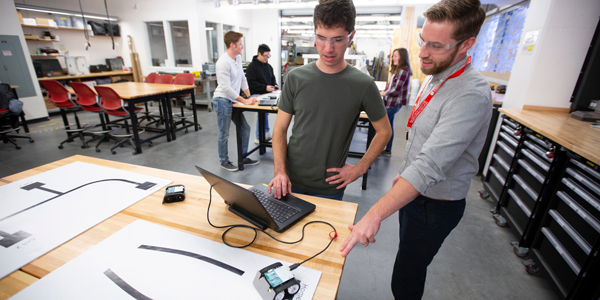
Teaching to Troubleshoot with Tech
When other kids were asking for toys or video games, Thomas Demers was asking for full-size tractors and combines. He was a gearhead from day one.
“My parents bought me the DVD series ‘All About John Deere,’” Demers says. “I remember a video of an orchard tractor Deere had set up autonomously. The farmer operated the tractor from his house by remote control. I thought, ‘Man, that is cool.’ That was the first real-life application I had seen of precision agriculture.”
Demers is a junior studying agricultural systems technology. This fall, he traveled home weekly to Storm Lake, Iowa, to drive the combine during harvest. Someday soon, Demers sees the farming process – from planting to harvest – moving toward an integration of robotics and human supervision.
John Haughery, an assistant professor of agricultural and biosystems engineering, agrees.
“We’re using more automatic or robotic systems,” Haughery says. “That’s the nature of how technology is trending.”
Real-world Robotics
Haughery (‘17 PhD industrial and agricultural technology) teaches both introductory and advanced courses in technology systems management. In his introductory course, Solving Technology Problems (TSM 115), students like Demers don’t just draft code for robots. They actually program a robot with their code and set it to follow a driving course.
The robots are square and about the length of a student’s hand. They run on two continuous bands of tread driven by wheels with a circuit board visible from above. Their route is a black line printed on a table-sized foam board. Each robot mimics actions found in the field — following a row of crops, turning at the end rows, or slowing to unload grain. Brayden Geilenfeldt, a sophomore in industrial technology, had never coded before signing up for Haughery’s course. True to the course name, Geilenfeldt found himself troubleshooting with his group to solve problems.
“The part that stuck with me the most was the class when our robot just wouldn’t work,” he says. “Something was wrong in the code. That drove me to want to figure out the problem, since I could see it not working in front of me.”
Advanced Teaching Technology
Geilenfeldt’s motivation to problem-solve isn’t a happy coincidence. Haughery is actively designing and leading his course with a focus on the scholarship of teaching
and learning. He bases class activities on what previous studies tell him works or doesn’t work.
“It’s a down-and-dirty, rubber meets-the-road way to get to the best possible teaching methods,” Haughery says. “You make a change, you collect the data, you analyze that data and
you find the benefits or detriments of the process so that you can change it the next time.”
In his robotics courses, Haughery pulls out all the stops to find what is working for his students. He tracks grades, analyzes course evaluations and holds appraisals throughout the semester to discover whether the students are picking up more through hands-on work with the robots.
“What we’ve found is robots give our students a tangible feedback loop,” Haughery says. “They develop a program, they upload it to the robot and then they watch the robot run. Let’s be honest — it usually doesn’t work the first time. But they can see where it stops working.”
During the preliminary stage of his research, Haughery found final grades increased by 3% on average when students worked with robotics in a hands-on environment. He also saw higher scores from students who worked with a robot, in comparison with those who only completed the coding assignments.
Though more quantitative data is needed to prove a statistical significance of hands-on robotics activities heightening motivation in the classroom, students are already applying practical lessons — an attention to methodical problem solving and an understanding of the system as a whole.
Critical thinking, future focused
“Technology is changing so quickly in my field,” Geilenfeldt says. “The more I know now, the better I’ll be able to adapt during my career. I’ll be able to understand the system, but
also the jobs of the people I’ll be working with or managing. I won’t worry that I can’t do something because I may break it. I can take it apart, and I can put it back together.”
Haughery says that holistic approach is what makes his students so prepared for the workforce.
“We work hard to impart to our students a systems-thinking approach,” Haughery says. “We consider everything from designing the equipment, to manufacturing, to effective and sustainable management, to the ecosystem we’re using the equipment in and the people using it. We want to connect them to the bigger picture. We have a better chance of finding positive solutions if we look at the holistic system. Sometimes the bigger the problem, the farther we need to zoom out to find the answer.”
##



